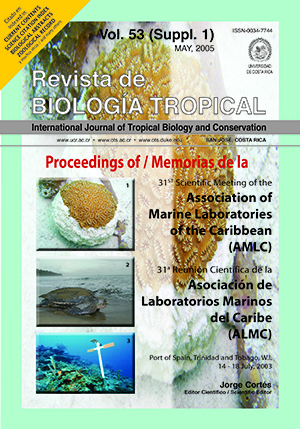Resumen
El uso de compuestos químicos como plaguicidas y como herbicidas ha incrementado la contaminación ambiental, afectando la ictiofauna que vive en ríos y depósitos de agua. Estudiamos el efecto de un herbicida (2-cloro-4,6-bis-etlamina-s-triazina) sobre el riñón de dos especies de peces (Caquetaia kraussii y Colossoma macropomum), ampliamente encontradas en los ríos caribeños y sudamericanos. En Venezuela son abundantes y tienen un alto potencial en acuacultura debido a que pueden ser cultivados y reproducidos en cautiverio. Se disectó el riñón a cuatro individuos jóvenes de cada especie que habían sido expuestos al herbicida y se les examinó con Microscopía Electrónica de Transmisión. Se encontraron alteraciones en los túbulos del riñón que incluían pérdida de plasmalema e interdigitaciones celulares, mitocondrias alteradas, disminución en el retículo endoplásmico, polisomas libres y la presencia de vacuolas autofágicas y lisosomas primarios. Estas alteraciones a nivel celular pueden explicar la conducta de los peces en términos de patología de los túbulos del riñón y las cantidades relativas y condiciones de organelas dentro de las células afectadas.Citas
Arisyoshi, T., S. Shiiba, H. Hasegawa & K. Arizono. 1990. Profile of metal binding proteins and heme oxygenase in red carp treated with heavy metals, pesticides and surfactants. Bull. Environ. Contam. Toxic. 44: 643-649.
Cooper, R.L. & R.J. Kaviock. 1997. Endocrine disruptors and reproductive development: a weight-of-evidence overview. J. Endocrin. 152: 159-166.
Denoyelles, F., W.D. Kettle, C.H. Fromm, M.F. Moffett & S.L. Dewey. 1989. Use of experimental ponds to assess the effects of a pesticide on the aquatic environment. Miscel. Publ. No. 75, 34th Ann. Meet. Entomol. Soc. Amer., Nov. 29 - Dec. 3, 1987. MPPEAL 75: 1-88.
Diana, S.G., W.J. Resetarits Jr., D.J. Schaeffer, K.B. Beckmen & V.R. Beasley. 2000. Effects of atrazine on amphibian growth and survival in artificial aquatic communities. Environ. Toxic. Chem. 19: 2961-2967.
Felsot, A.S. 2001. Herbicide tolerant genes, Part 4. Withering wildlife?. Agrichem. Environ. News 178: 1-8.
Gomez, L., J. Masot, S. Martínez, E. Durán, F. Soler & V. Roncero. 1998. Acute 2,4-D poisoning in tench. (Tinca tinca L.): Lesions in the haematopoietic portion of the kidney. Archiv. Environ. Contam. Toxic. 35: 479-483.
Gonzalez, J. & B. Heredia. 1998. El cultivo de la cachama (Colossoma macropomum). Maracay, Venezuela, FONAIAP. Centro de Investigaciones Agropecuarias del Estado Guárico. 134 p.
Hamm, J.T. & D.E. Hinton. 2000. The role of development and duration of exposure to the embryotoxicity of diazinon. Aquat. Toxic. 48: 403 418.
Hayes, T.B., A. Collins, M. Lee, M. Mendoza, N. Noriega, A.A. Stuart & A. Vonk. 2002. Hermaphroditic, demasculinized frogs after exposure to the herbicide atrazine at low ecologically relevant doses. Proc. Nat. Acad. Sci. (U.S.A.) 99: 5476-5480.
Larkin, D.J. & R.S. Tjeerdema. 2000. Fate and effects of diazinon. Review Environ. Contam. Toxic. 166: 49-82.
Lauren, D.J., A. Wishkovsky, J.M. Groff, R.P. Hedrick & D.E. Hinton. 1989. Toxicity and pharmacokinetics of the antibiotic fumagillin, in yearling rainbow trout (Salmo gairdneri). Toxic. App. Pharmac. 98: 444-453.
Medina, J. 1995. Informe de Gestión. FONAIAP. Estación Experimental Guárico. Sub-Estación Guanapito. 56 p.
Mallat, J., J.F. Bailey, S.J. Lampa, M.A. Evans & S. Brumbaugh. 1995. A fish gill system for quantifying the ultrastructural effects of environmental stressors: methylmercury, Kepone and heat schock. Canad. J. Fish. Aquat. Sci. 52: 1165-1182.
Powell, M.D., G.M. Wright & D.J. Speare. 1995. Morphological changes in rainbow trout (Oncorhynchus mykiss) gill epithelia following repeated intermittent exposure to chloramines T. Canad. J. Zool. 73: 154-165.
Rolf, L.L., M.D. Setser & J.L. Walker. 1986. Pharmacokinetics and tissues residues in chanel catfish, Ictalurus punctatus, given intracardiac and intramuscular injections of gentamicin sulphate. Vet. Hum. Toxic. 28 (Suppl 1): 25-31.
Segnini de Bravo M.I. & K.S. Chung. 2001 Ecophysiological Behavior of Caquetaia kraussi exposed to different temperatures and salinities. Rev. Biol. Trop. 49: 141-156.
Struger, J. & S. Painter. 1997. Endocrine disruptions in the great lakes basin: an assessment of agricultural and industrial inputs. Soc. Environ. Toxic. Chem. SETAC 18th Ann. Meet. Abstract Book. PWA140. Pp. 255.
Szarek, J., A. Siwicki, A. Andrzejewska, E. Terech-Majewska & T. Banaszkiewicz. 2000. Effect of herbicide roundup super TM on the structural pattern of hepatocytes in carp. Mar. Environ. Res. 50: 263-266.
Wester, P.W. & J.H. Canton. 1986. Histopathological study of Oryzias latipes (medaka) after long term β-hexachlorocyclohexane exposure. Aquat. Toxic. 9: 21-45.
Wester, P.W., J.H. Canton, A.A.J. van Lersel, E.I. Krajnc & H.A.M.G. Vaessen. 1990. The toxicity of bis(tris-n-butyltin)oxide (TBTO) and di-n-butyltindi-chloride (DBTC) in the small fish species Oryzias latipes (medaka) and Poecilia reticulata (guppy). Aquat. Toxic. 16: 53-72.
Wiegand, C., S. Pflugmacher, M. Giese, H. Frank & C. Steinberg. 2000. Uptake, toxicity and effects on detoxication enzymes of atrazine and trifluoroacetate in embryios of Zebrafish. Ecotox. Environ. Safety 45: 122-131.
Wiegand, C., E. Krause, C. Steinberg & S. Plugmacher. 2001. Toxicokinetics of atrazine in embryos of the zebrafish (Danio rerio). Ecotox. Environ. Safety 49: 199-205.
Comentarios

Esta obra está bajo una licencia internacional Creative Commons Atribución 4.0.
Derechos de autor 2005 Revista de Biología Tropical






